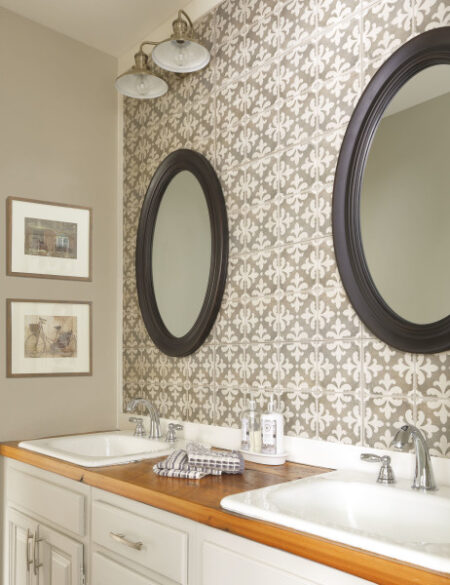This content was originally published on OldHouseOnline.com and has been republished here as part of a merger between our two businesses. All copy is presented here as it originally appeared there.
When Rick and Mary Lou Ponder bought their 1886 house in St. Louis, a priority was the poorly remodeled master bath, which had purple paint and a green tile floor. They kept the clawfoot tub and, inspired by an 1888 plumbing catalog, decided to surround it with paneling. Then they found an antique toilet and marble sink. At Shellenberger Architectural Antiques in York, Penn., they bought a huge, burled-walnut armoire. Disassembled, it would provide all the parts needed.
Disassembly & Refinishing
Working on his patio to avoid toxic fumes, Rick Ponder first loosened the armoire’s joints, using white vinegar that had been heated in a microwave oven. He gently separated the doors and side panels. After disassembly, parts were stripped using a semi-paste stripper from Sherwin-Williams (using a wire brush, scrapers, and steel wool). The wood was sanded with fine-grit paper, dusted with a soft brush, and wiped with a dry tack cloth.
The stripped paneling was finished with four coats of Deft Spray Lacquer (the wood lightly sanded and wiped with a tack cloth between coats).

Reconstruction
Rick measured the dimensions for the tub, then cut panels with a radial arm saw, to construct a 29″ tall x 70″ wide (room-width) panel for the front, and 15″ tall x 20″ long panels for the back and sides. He glued it up with Gorilla Wood Glue and secured the panels with 2″ wood screws. As the tub was several inches shorter than the panels, Rick had set it on wood blocks secured to the floor with 5″ wood screws, which raised it to the lip of the surround.

A three-sided enclosure was made for the high toilet tank. Decorative, carved crests had been above the armoire’s doors, but they were 6″ too wide for the tank enclosure, so Rick remade them. He removed the carvings with hot vinegar, shortened the back piece, then refastened the carved flowers and balls to it by gluing and clamping. The intact armoire mirror was recycled to become the mirror over the vanity. He secured it through to the wall studs using wood screws, and similarly shortened the other crest to be used here.
Finished now with a tin wainscot and ceiling, a hobnail-glass library light fixture, salvaged encaustic floor tiles, and an antique ruby-glass window, the room is an elegant nod to the 1880s.











